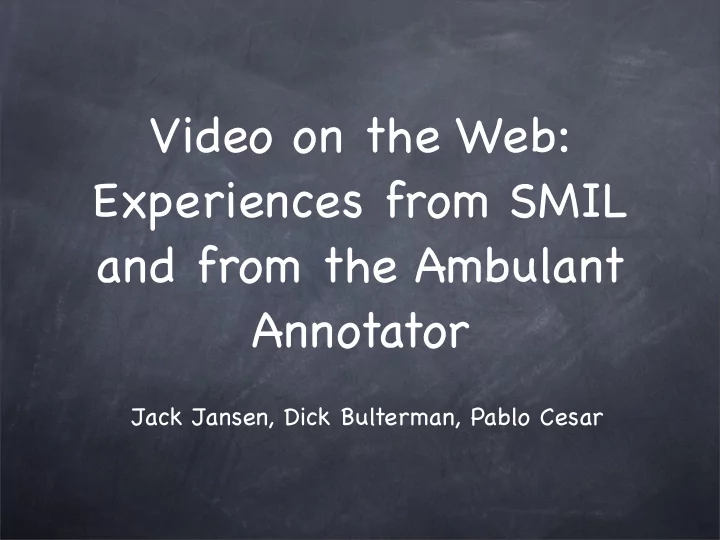

Video on the Web: Experiences from SMIL and from the Ambulant Annotator Jack Jansen, Dick Bulterman, Pablo Cesar
Contents Introduction Using SMIL to structure video Only minimal SMIL needed Example: video-based web application
Video on the Web Opaque blob Minimal scripting controls (play/stop/pause) Timing information is lost Even current HTML5 ideas don’ t help here All this is also true for audio, other timed media
What we want Ability to structurally mark up video without touching the data: DRM issues Enable end-user/third-party markup Enables symbolic addressing of subparts Enables time-based metadata Enables time-based annotation
SMIL video - minimal <video src=”biketour.mp4”/>
SMIL video - structured <seq> <video clipEnd=”14s” src=”biketour.mp4”/> <video clipBegin=”14s” clipEnd=”32s” src=”biketour.mp4”/> <video clipBegin=”32s” src=”biketour.mp4”/> </seq> Plays back identical (modulo player bugs:-) to single <video> tag of the previous slide.
SMIL video - addressing <seq> <video xml:id=”intro” clipEnd=”14s” src=”biketour.mp4”/> <video xml: id=”hotels” clipBegin=”14s” clipEnd=”32s” src=”biketour.mp4”/> <video xml: id=”tour” clipBegin=”32s” src=”biketour.mp4”/> </seq> Now we can jump into the middle of the video.
SMIL video - metadata <seq> <video id=”intro” .../> <video id=”hotels” clipBegin=”14s” clipEnd=”32s” src=”biketour.mp4”> <meta name=”description” value=”Hotel Information”/> </video> <video id=”tour” .../> </seq> Now we have time-based metainformation. (we could have used RDF in this example too, but unfortunately the slide is not big enough:-)
SMIL video - linking <seq> <video id=”intro” .../> <video id=”hotels” clipBegin=”14s” clipEnd=”32s” src=”biketour.mp4”> <area begin=”2s” end=”5s” shape=”rect” coords=”120,100,400,150” href=”tram-schedule.html”/> </video> <video id=”tour” .../> </seq> And we have hyperlinks with temporal and spatial boundaries. Note: <area> times are relative to parent <video>.
SMIL video - annotation <seq> <video id=”intro” .../> <par> <video id=”hotels” clipBegin=”14s” clipEnd=”32s” src=”biketour.mp4”/> <smilText region=”caption”> Hotel Information </smilText> </par> <video id=”tour” .../> </seq> And we can add time-based annotations.
Case study - Video in a web app Guided tourist tour, basically a linear video with optional content (user selectable) Topics of interest Subtitles video timeline controls webpage content Hyperlinks to background info Advertisements
Implementation overview Webpage with XForms and embedded SMIL 3.0 CR player All logic is declarative only very localised scripting reusable
Demo video Adapting video to preferences also while playing Video timeline controls webpage GPS locations links to additional material
Video
Architecture SMIL XForms document document Model, instance SMIL State XML document shared data
SMIL influences HTML Time SMIL Scene1 Scene2 Scene3 Scene4 HTML Show new link Data var=www.example.com
XForms influences SMIL Time SMIL Scene1 Scene2 Scene3 Scene4 Is var2 true? XForms User interaction Data var2=1 var2=0
SMIL State advantages Clean separation: the data is the API Replace Google Maps by MS Maps Use another ad service reuse Some scripting apps can now be done declaratively reuse, again
Conclusions SMIL allows timed media to be first-class citizen on the web by adding structure! without touching it! SMIL 3.0 State enables time-based web apps
Recommend
More recommend